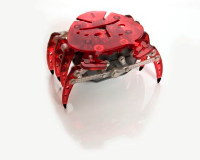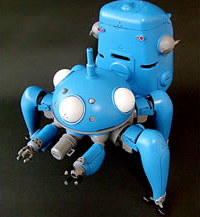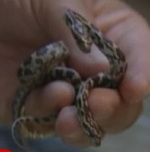Animals
Jumping Ants
A hypnotic video of jumping ants. The ant-leaping goodness starts about 45 seconds in.
Posted By: Alex - Wed Jul 23, 2008 -
Comments (3)
Category: Animals
Peruvian Guinea Pig Festival
Every year the residents of Huacho, Peru hold their Guinea Pig festival. First they dress the guinea pigs in cute costumes. There's a fashion show to decide the best-dressed guinea pig. Then they cook 'em up. The Telegraph notes that "Guinea pigs can be served fried, roasted or in a casserole... The meat tastes like rabbit or the dark meat of chicken, in case you were wondering." (via J-Walk)
Posted By: Alex - Wed Jul 23, 2008 -
Comments (4)
Category: Animals, Food, Parades and Festivals
Imaginary Animals
Brazilian artist Alexandre Jorge has created a series of creepy imaginary animals. They're all made out of papier mache. I figure it's only a matter of time before the pictures start popping up in people's email with the claim that they're real animals found in the Brazilian rainforest (or something like that): |  |  |
 | ||
 |  |  |
(via Forgetomori)
Posted By: Alex - Thu Jul 17, 2008 -
Comments (1)
Category: Animals, Art
Mechanical Elephants
Once upon a time, mechanical elephants roamed up and down the boardwalks of beaches. Check out the clip below from a 1950s newsreel. The elephant, built by Frank Stuart was "Gasoline Powered with a 4 cylinder English Side Valve Ford engine. Top speed 27 MPH!"I found the clip on the blog of Eastcliff Richard who reports that, "Astonishingly Britain used to lead the world in the production of mechanical elephants. This one was later sold to the late, great, dearly-departed Peter Sellers as part of his eccentric collection of automobilia."
Some more videos of mechanical elephants can be found here and here.
Posted By: Alex - Thu Jul 17, 2008 -
Comments (1)
Category: Animals, Inventions, Technology
Barnyard of the Gods
At the fascinating blog of my pal, Rudy Rucker, I recently found the archaically NSFW image hidden beyond the jump. Rudy utilized a picture taken by a friend of his, while I've found my image at a site claiming the sculpture in question is housed at the Secret Museum of Naples.In either case, I thought this was just the kind of bizarre thing WU readers might care to ponder.
More in extended >>
Posted By: Paul - Wed Jul 16, 2008 -
Comments (4)
Category: Animals, Art, Gods, History, Museums, Sexuality
Robo-Crabs



Posted By: Alex - Tue Jul 15, 2008 -
Comments (1)
Category: Animals, Inventions, Technology
Pavlovian Fish
Ivan Pavlov famously conditioned dogs to salivate every time they heard a dinner bell. The U.S. Army hopes to use a similar technique to train fish in Buzzards Bay off the coast of Massachusetts. According to the Cape Cod Times, the experiment:The experiment has raised concerns among a consumer advocacy group, who are suing the Army, but that's not what interests me. What interests me is whether the fish salivate when they hear the tone. Do fish, in fact, have salivary glands? An answer from genuineideas.com:
And that's your weird fish fact of the day.
Posted By: Alex - Sun Jul 13, 2008 -
Comments (1)
Category: Animals, Experiments
Two-Headed Snake

Apparently they're going to call them Bush and Rove.
(Thanks to Big Gary for the link and the joke.)
Posted By: Alex - Fri Jul 11, 2008 -
Comments (0)
Category: Animals
Plastic Pink Flamingo Shortage imminent!
Crude oil heading toward $200.00 a barrel? Trivial! More important here at WU Central is the upcoming dearth of avian lawn ornaments as the company that makes them goes bankrupt!
Read the whole sad story here.
How will extortionate charities get their money now, if the practice of "flamingoing" is doomed?
Posted By: Paul - Thu Jul 10, 2008 -
Comments (10)
Category: Animals, Business, Products, Customs, Domestic, Inventions

| Who We Are |
|---|
| Alex Boese Alex is the creator and curator of the Museum of Hoaxes. He's also the author of various weird, non-fiction, science-themed books such as Elephants on Acid and Psychedelic Apes. Paul Di Filippo Paul has been paid to put weird ideas into fictional form for over thirty years, in his career as a noted science fiction writer. He has recently begun blogging on many curious topics with three fellow writers at The Inferior 4+1. Contact Us |




